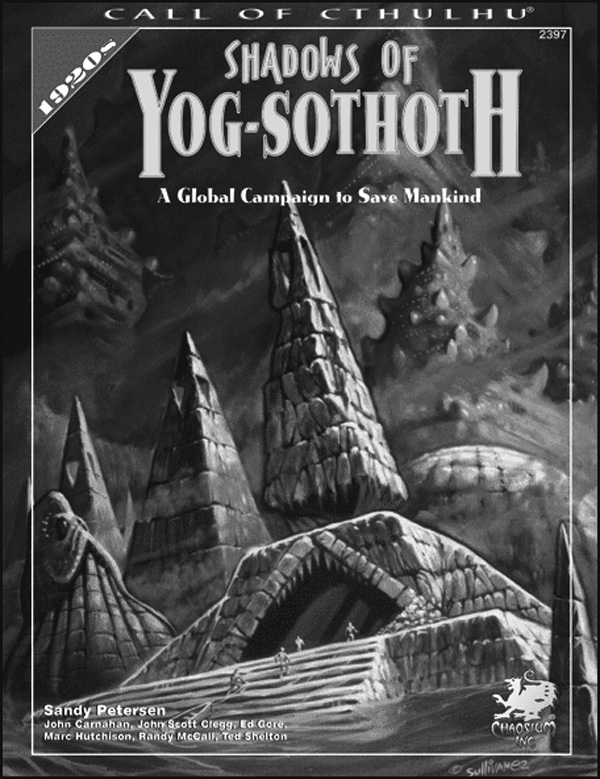By John Carnahan, John Scott Clegg, Ed Gore, Marc Hutchison, Randy McCall, Sandy Petersen and Ted Shelton with Lynn Willis, Jeff Carey and Don Coatar
Published by Chaosium, Inc.; $23.95
Review by Matthew Pook
The importance of Shadows of Yog-Sothoth cannot be overstated. The first campaign for Call of Cthulhu, it paved the way for many classics to come and it introduced the concept of the onionskin campaign. This has the investigators stripping away layers of information like the skin of an onion as the players progress through the campaign, revealing more of the evil cult’s plans and coming closer to the heart of the adventure.
In Shadows of Yog-Sothoth, that cult is the Masters of the Silver Twilight, an international organization dedicated to a single aim. Dread Cthulhu sleeps still in the sunken city of R’lyeh yet stirs as the stars converge. Even though the stars are not quite right, the cult believes it can force the premature rise of the city and release the Great old One. The campaign against the cult is broken into seven parts, taking the investigators from Boston to New York, then Scotland, California, Maine, and finally Easter Island and the South Pacific.
The campaign opens in Boston in 1928 with the investigators invited to join “The Hermetic Order of the Silver Twilight,” a rich, well-to-do, misogynistic fraternity with a reputation for charitable works. When the characters are promoted above the publicly known ranks, the Order reveals the truth, that it worships no earthly god and is awaiting the time when the stars come right and alien deities can reclaim what once was theirs.
The first of several letters directs the investigators to New York, the home of an odd business organisation, “Look to the Future.” Its strange actualization ceremonies appear to send individuals into the future who return with fascinating items such as pocket-sized radios and non-stick cooking pans. The items suggest that time travel works; but why does everyone seem so tired?
A second letter asks them to look into the disappearance of a noted American big game hunter and archaeologist from his village home of Cannich in Scotland. There the characters must contend with suspicious locals as well as strange foreigners working at a loch-side dig. Where “Look to the Future” is short and focused, “The Coven of Cannich” is a sprawling affair with almost 20 NPCs for the Keeper to handle. There is also a lack of urgency to the adventure, despite the events it suggests, and the Keeper is very much left to cope on his own.
Back in the U.S.A., a movie mogul hires them to visit “Devil’s Canyon” and discover what caused the suicide of the director of his latest movie, the lead actress’ death and the lead actor’s madness. Set in the Mojave Desert, this has a pleasing sense of isolation as the investigators are menaced by forgotten links to a lost Indian tribe.
What seems like a welcome into the arms of a benefactor turns into a series of increasingly lethal encounters in “The Worm that Walks.” Set in Maine, this is the cult’s revenge for the investigators’ meddling.
Up until now the investigators have been reacting to letters received, but their chance to be pro-active comes in “The Watchers of Easter Island” and the “Rise of R’lyeh,” the last two parts of the campaign. With artifacts and clues acquired in previous chapters, the heroes must face the ultimate challenge in Call of Cthulhu—to step onto the newly risen island of R’lyeh and prevent the rise of the being at the heart of both the game and the Mythos, Cthulhu himself.
The book is rounded out with two separate scenarios, “The People of the Monolith” and “The Warren,” which, like the campaign, show their age.
Originally published in 1982, and reprinted in 1989 as part of Cthulhu Classics, this campaign has long been regarded as a flawed classic with numerous problems. Its setup is weak and it is difficult to get investigators involved. The links between the chapters are flimsy and awkward, and the constant use of the letter as a plot device is wearisome. The fifth part, “The Worm that Walks,” is notorious as an exercise to kill player characters at a point when their knowledge and experience are needed for the last two scenarios. The campaign lacks Keeper advice. Having been written by different hands, it has a rough, incohesive feel.
Chaosium has attempted to address some of these problems with these reprints. These begin with “The Hermetic Order of the Silver Twilight,” suggesting reasons the investigators would join the Order and providing plenty of NPCs for them to interact with. Every NPC is illustrated; each chapter lists selected links between it and the other parts; and there is a little—often too little—Keeper advice for each chapter, though not for the campaign as a whole.
Ultimately, Chasoium’s failure to fully address the problems in Shadows of Yog-Sothoth leaves it still showing its age. Running it is a daunting prospect for any but the most experienced Keepers. Individually, some of its scenarios are creepy little affairs and it gives a genuine reason for the investigators to face Great Cthulhu himself, but until it receives a rewrite, Shadows of Yog-Sothoth does not quite live up to its ambitions. It gets 6 phobias.

